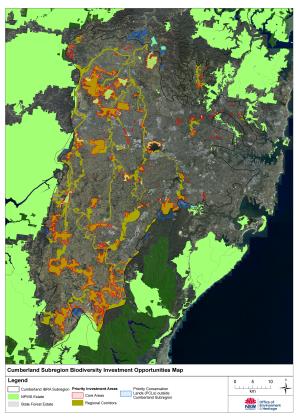The map was prepared with funding provided by the NSW Environmental Trust.
Information on the purpose of the BIO Map is available on the BIO Map web page. It is important to note that the inclusion of land within the BIO Map does not alter a landholder's right to carry out agricultural and developmental activities. The BIO Map identifies land that may have increased opportunities to access a range of conservation funding programs. Participation in these programs is entirely voluntary.
The BIO Map for the Cumberland subregion covers a 275,693-hectare area containing the Cumberland Plain, a broad shale basin in western Sydney. Mapping criteria were used to identify and map priority investment areas, and targeted stakeholder consultation was conducted to inform the outputs of the project. Stakeholders consulted included the Commonwealth Department of the Environment, six state government authorities, 16 local councils and eight non-government organisations.
The priority investment areas comprise of a network of 87 core areas and 27 regional biodiversity corridors within the Cumberland subregion. The 87 core areas include all of the priority conservation lands identified by the Cumberland Plain Recovery Plan. The total area represented within the mapped priority investment areas is 42,124 hectares. This represents approximately 15 per cent of the Cumberland subregion or approximately 61 per cent of all mapped vegetation within the subregion.
The BIO Map spatial data can be downloaded from SEED (search using the term 'BIO Map') and is also viewable on the Biodiversity Investment Spatial Viewer.
Maps for Local Government Areas
The Cumberland subregion BIO Map identifies priority investment areas across 16 local government areas in western Sydney. Sections of the BIO Map for these local government areas are available below:
- Bankstown local government area (PDF 714KB)
- Blacktown local government area (PDF 712KB)
- Camden local government area (PDF 659KB)
- Campbelltown local government area (PDF 656KB)
- Canterbury local government area (PDF 707KB)
- Fairfield local government area (PDF 742KB)
- Hawkesbury local government area (PDF 701KB)
- Hornsby local government area (PDF 667KB)
- Hurstville local government area (PDF 678KB)
- Ku-ring-gai local government area (PDF 714KB)
- Liverpool local government area (PDF 846KB)
- Parramatta local government area (PDF 759KB)
- Penrith local government area (PDF 688KB)
- Ryde local government area (PDF 788KB)
- The Hills local government area (PDF 667KB)
- Wollondilly local government area (PDF 705KB)



